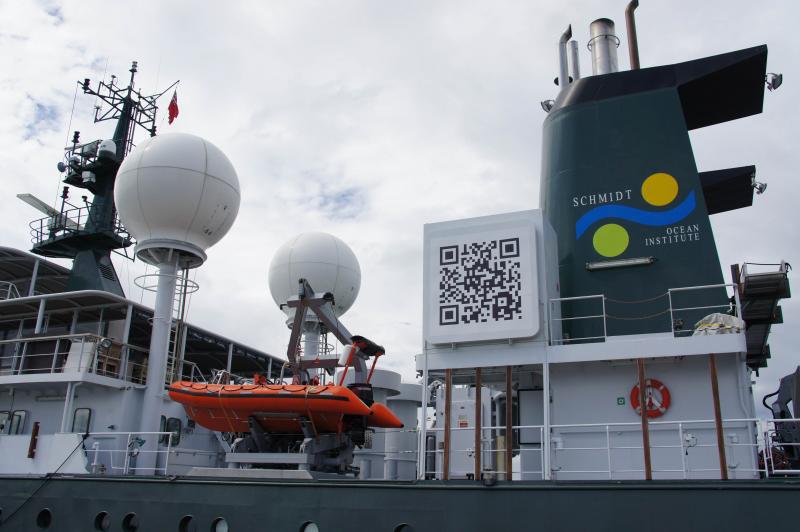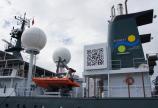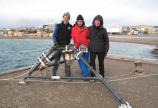An ocean full of change at Ocean Networks Canada
- Virginia Keast

Having established the world’s first and largest comprehensive underwater cabled ocean observatories, Ocean Networks Canada continues to expand the scope of its activities. This summer and fall, ONC is taking part in a major cruise investigating low-oxygen zones, adding new capabilities to its Arctic node, participating in a major international trade mission and making substantial enhancements to its website.
A monthlong cruise chasing “dead waters”
Since mid-August, ONC has been leading a scientifically oriented month-long expedition to study low-oxygen waters off the coast of Vancouver Island. The mission’s first leg is now complete, after two weeks of tracing the pathways of potentially harmful low-oxygen waters as they flow from the deep ocean toward our coast. The team of seven Canadian scientists, four technicians and five students have been on board the RV Falkor, the 272-foot, $62 million ocean research vessel provided by the Schmidt Ocean Institute—a private foundation established by Google co-founder Eric Schmidt and his wife, Wendy.
This was a remarkable opportunity for our research community, to gain access to this world-class ship and conduct unrestricted observations in our local waters,” reflects Dr. Richard Dewey, who served as Chief Scientist during the first leg of the journey. “The ship is extremely well equipped, and the crew and officers were consummate professionals. We traversed over 3,400 km and collected 2,800 water column profiles.”
Principal investigator Professor Jody Klymak from the School of Earth and Ocean Sciences was also on board working with UVic’s moving vessel profiler, an impressive workhorse on this expedition. Acting as part of the science team, UVic student Brianna Cerkiewicz experienced the thrill and hard work of her very first cruise and blogged her shipboard adventures on the ONC Wiring the Abyss website.
The Falkor is now berthed at Victoria’s Ogden Point to re-mobilize for the second half of the expedition, which will run until September 18. For the second leg, the vessel will host another team of scientists who will re-visit the pathways with a focus on how ecosystems may be impacted. They’ll also watch the seafloor via ROPOS, a remotely operated submersible that streams live video during its dives to the seafloor. This portal to the ocean is open to everyone via the internet at the Wiring the Abyss 2013 website, and a media release about the benefits of the ship-based research to ONC projects is also available.
Arctic mini-observatory gets a reboot
Built with the same world-class technology as the VENUS and NEPTUNE observatories, the mini-observatory at Cambridge Bay, Nunavut, has just passed its first annual check-up. An ONC engineering team hoisted the undersea platform onto the town’s busy dock for maintenance and performed equipment upgrades including a new hydrophone for listening to the sounds beneath the surface of the Arctic Ocean.
BC ocean technology explores commercial opportunity abroad
Across the Pacific Ocean, ONC’s Innovation Centre (formerly ONCCEE) is on a two-week trade mission to explore the commercial potential of the many engineering breakthroughs which made the observatories a reality. The first stop is Shanghai, for the inaugural International Oceanology exhibition, as China ramps up its plan for a “Blue Economy” focused on ocean resource and technology development. In Shanghai, BC’s Ministry of International Trade hosted a BC Pavilion for eight organizations to highlight our province’s expertise in the ocean sector. The ONC delegation then visited five major cities spanning the eastern coast, to further explore partnership opportunities.
A new look for ONC— and a new website
At the northern periphery of the UVic campus, the remaining staffers who hadn’t rushed off to the Arctic, or to China, or to explore water columns in the Northeast Pacific Ocean have been busy creating a brand new look for ONC, to accompany its new five-year strategic science plan and new organizational structure. Much like other changes afoot at ONC, the new website is designed to increase capacity, improve access and better encourage public engagement for the world-leading ocean observatories. The new oceannetworks.ca site brings together four previous sites and improves access for everyone—from researchers to teachers, industry partners to citizen scientists.
Oceans Alive ready to take TV audiences to the deep
Later this month, after years of planning and polishing, the work of ONC will be brought to television audiences as well—appearing on ShawTV and online, in a series of programs designed to deepen public awareness of ocean science and its relevance to our changing world. The resulting television series integrates social media, mobile apps and interactive games to lead people into the world of the deep sea. The first Ocean Alive! special will be broadcast on ShawTV and online at oceannetworks.ca on Sept. 24. A sneak peak appears at vimeo.com/67918755


